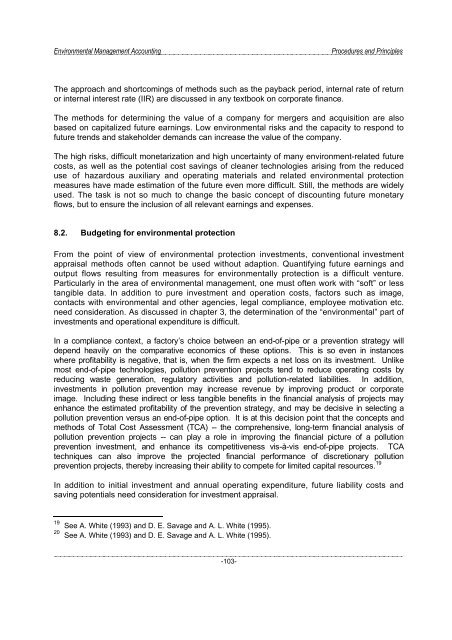Environmental Management Accounting Procedures and Principles
Environmental Management Accounting Procedures and Principles
Environmental Management Accounting Procedures and Principles
You also want an ePaper? Increase the reach of your titles
YUMPU automatically turns print PDFs into web optimized ePapers that Google loves.
<strong>Environmental</strong> <strong>Management</strong> <strong>Accounting</strong><br />
<strong>Procedures</strong> <strong>and</strong> <strong>Principles</strong><br />
The approach <strong>and</strong> shortcomings of methods such as the payback period, internal rate of return<br />
or internal interest rate (IIR) are discussed in any textbook on corporate finance.<br />
The methods for determining the value of a company for mergers <strong>and</strong> acquisition are also<br />
based on capitalized future earnings. Low environmental risks <strong>and</strong> the capacity to respond to<br />
future trends <strong>and</strong> stakeholder dem<strong>and</strong>s can increase the value of the company.<br />
The high risks, difficult monetarization <strong>and</strong> high uncertainty of many environment-related future<br />
costs, as well as the potential cost savings of cleaner technologies arising from the reduced<br />
use of hazardous auxiliary <strong>and</strong> operating materials <strong>and</strong> related environmental protection<br />
measures have made estimation of the future even more difficult. Still, the methods are widely<br />
used. The task is not so much to change the basic concept of discounting future monetary<br />
flows, but to ensure the inclusion of all relevant earnings <strong>and</strong> expenses.<br />
8.2. Budgeting for environmental protection<br />
From the point of view of environmental protection investments, conventional investment<br />
appraisal methods often cannot be used without adaption. Quantifying future earnings <strong>and</strong><br />
output flows resulting from measures for environmentally protection is a difficult venture.<br />
Particularly in the area of environmental management, one must often work with “soft” or less<br />
tangible data. In addition to pure investment <strong>and</strong> operation costs, factors such as image,<br />
contacts with environmental <strong>and</strong> other agencies, legal compliance, employee motivation etc.<br />
need consideration. As discussed in chapter 3, the determination of the “environmental” part of<br />
investments <strong>and</strong> operational expenditure is difficult.<br />
In a compl iance cont ext , a fact ory ’s choi ce between an end-of- pipe or a pr event ion st rategy wil l<br />
depend heavi ly on the compar ati ve ec onomic s of these options . Thi s is so ev en in instances<br />
wher e prof it abi lit y is negat ive, that is, when the firm ex pects a net loss on its inves tment . Unl ik e<br />
most end-of- pipe tec hnologies, pol lution prevention projec ts tend to reduc e operat ing cost s by<br />
reducing was te gener ati on, regulat or y acti vi ties <strong>and</strong> polluti on- rel at ed liabi lit ies . In addi tion,<br />
investment s in pol lution prevention may incr eas e rev enue by improv ing produc t or cor por ate<br />
image. Incl udi ng these indi rec t or les s tangible benefit s in the financ ial anal ysi s of projects may<br />
enhance the est imated prof it abi lit y of the prev ent ion strategy, <strong>and</strong> may be deci siv e in sel ec ting a<br />
poll uti on pr eventi on versus an end-of-pipe opti on. It is at this decis ion point that the concepts <strong>and</strong><br />
methods of Total Cos t Assess ment (TCA) -- the comprehensiv e, long- term financial analys is of<br />
poll uti on pr eventi on pr oject s -- can pl ay a rol e in improv ing the fi nancial pic tur e of a pol lut ion<br />
pr ev ent ion investment, <strong>and</strong> enhance its competit iveness vis -à-vi s end- of- pipe projec ts . TCA<br />
techniques can als o improv e the pr oj ect ed fi nancial per for mance of disc ret ionar y pol lut ion<br />
pr ev ent ion proj ect s, thereby increas ing thei r abil it y t o c ompet e f or li mit ed capit al resourc es. 19<br />
In addition to initial investment <strong>and</strong> annual operating expenditure, future liability costs <strong>and</strong><br />
saving potentials need consideration for investment appraisal.<br />
19 See A. White (1993) <strong>and</strong> D. E. Savage <strong>and</strong> A. L. White (1995).<br />
20 See A. White (1993) <strong>and</strong> D. E. Savage <strong>and</strong> A. L. White (1995).<br />
-103-




